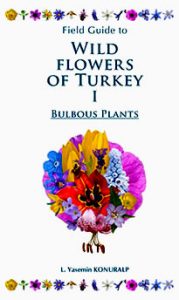 Dear Friends,
Dear Friends,
My name is Yasemin Konuralp and I live in Antalya, Turkey. I am the owner of the tour operating company Runner Tourism. I enjoy hiking, trekking and photographing. Working as a professional tour leader for 32 years, I developed an interest in the wildflowers of Anatolia and began to learn about them. Over the years I built up considerable knowledge about the endemic wildflowers of the country, together with a large collection of photographs.  In April 2013, I published my first field guide book, “Wildflowers of Turkey Volume I – Bulbous Plants“. (Türkiyenin yabani çiçekleri) A primary driver behind this wildflower book is the urgent need to prevent the dissappearance of native plant species in Anatolia, especially those that are endemic, by providing a wildflower field guide book for both travelers and locals. I believe people will actively support and promote the protection of natural species whenever they have better knowledge about the flora of Turkey.
In April 2013, I published my first field guide book, “Wildflowers of Turkey Volume I – Bulbous Plants“. (Türkiyenin yabani çiçekleri) A primary driver behind this wildflower book is the urgent need to prevent the dissappearance of native plant species in Anatolia, especially those that are endemic, by providing a wildflower field guide book for both travelers and locals. I believe people will actively support and promote the protection of natural species whenever they have better knowledge about the flora of Turkey.
In Turkey, wildflowers are suffering from the bulb hunters. The country has long been famed for its bulbs, having the richest variety of bulbs in the world, with great numbers of Orchid, Fritillary, Crocus, Colchicum and Cyclamen. This natural wealth mirrors the general richness of Turkish flora, which totals 11466 species, of which 3649 are endemic plants. This diversity stems principally from country`s geographical position, sandwiched between the steps of Central Asia, the deserts of Syria, the cold afforested mountains of Central Europe, and the Mediterranean to the west. At the turn of the 20th century, commercial collectors from Europe scoured the hills and the mountain sides of Anatolia in search of new and exciting bulbous plants. Local people were paid to help in this collecting. At the height of the trade some 71 million bulbs were exported in one year – including over 11 million Winter Aconites (Eranthis hyemalis), 10 million Grecian Wind-flowers (Anemone blanda), and a staggering 30 million Snowdrops (principally Galanthus elwesii). This is not just the past century`s problem, – mass collecting of flowers of Turkey started as early as the 17th century. As a result of all this collecting, we have already lost some of the endemic species and some of those remaining are endangered. And yet we are starting to see some success in preserving endangered species. Galanthus elwesii was just about to disappear, but with the help of alert botanists and naturalists, people were encouraged to grow these bulbs in their gardens rather than collect them from the wild. We now once again find collonies of these plants growing naturaly in the wilderness. If you are interested in spending your vacation on a botanical tour, combined with the visits to the archaeological sites of Turkey, please send me a message and request a detailed itinerary. In the spring of 2025, I can arrange a customized tour for you and gladly be your field guide. Please contact me if you are planning a visit to my country.
Yasemin Konuralp
